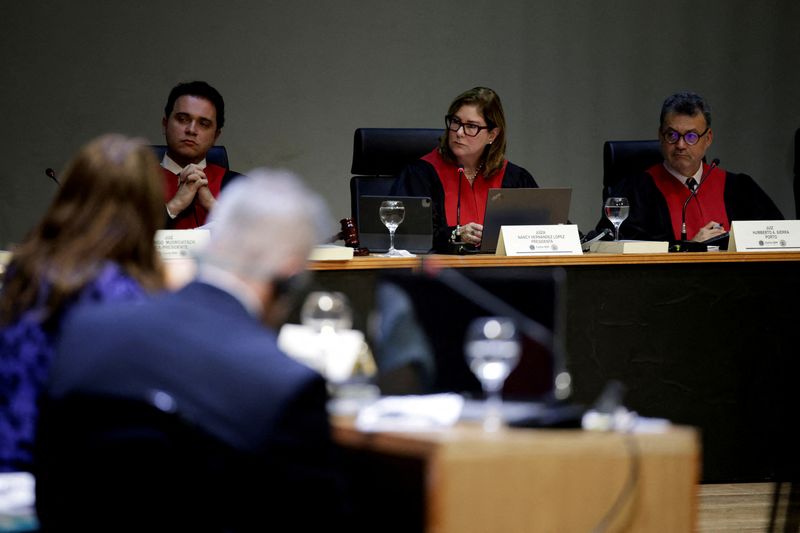By Jake Spring
SAO PAULO (Reuters) – Latin America’s human rights court will hold a final hearing in Brazil on Wednesday in a case that is part of a global wave of climate lawsuits, as several international courts prepare opinions for the first time on what countries should do to fight climate change .
The rulings could also trigger a wave of new lawsuits filed by citizens, companies and governments.
However, enforcement of such decisions is largely untested. For example, a Swiss parliamentary committee last week rejected a ruling by a top European court that said Switzerland had violated the human rights of its citizens by not doing enough to prevent climate change.
The Inter-American Court of Human Rights (IACHR), which has jurisdiction over 20 Latin American and Caribbean countries, hopes to issue an opinion by the end of the year, top judge Nancy Hernandez Lopez told Reuters. The final hearing will be held on Wednesday in the Amazon rainforest city of Manaus (NASDAQ:).
Just last week, the international tribunal established under the UN Law of the Sea decided that carbon emissions amount to marine pollution and that countries must go further than the Paris Agreement to protect the oceans.
Next year, the International Court of Justice (ICJ) is expected to have its say and could try to unify the court’s previous rulings into one global ruling that applies to all UN members.
“The reason for (the wave of lawsuits) is people’s deep frustration that their elected representatives are not taking swift and fair climate action,” said Lucy Maxwell, co-director of the nonprofit Climate Litigation Network.
“The landscape of climate disputes is very broad and diverse and growing enormously.”
CREATING PRECEDENTS
Although the opinions of multilateral courts apply only to the states under their jurisdiction, they all grapple with the same central question: are governments obliged to protect people from climate change? And if so – to what extent?
This question puts courts in uncharted territory, as there is little legal precedent on climate change. During their deliberations, court judges reviewed climate science, held hearings and sifted through a tangle of laws, treaties and U.N. procedures.
That process has made the case before the Inter-American Court the largest to date – with more than 600 participants in hearings in Brazil and Barbados, as well as 262 written submissions to the court from indigenous groups, civil society, scientists and one company . .
Such inclusivity helps earn the court its reputation as one of the most progressive in the world, lawyers said.
By comparison, the International Court of Justice has limited input in its case mainly to countries and authorities such as the World Health Organization.
The Latin American court could also borrow arguments from previous national climate cases, even if they fall outside its jurisdiction, says senior lawyer Sophie Marjanac at legal charity ClientEarth.
“The judges read each other’s opinions,” Marjanac said, although the influence of one ruling on another can be “more psychological and social than legal.”
As such, the Latin American court could influence the International Court of Justice’s ruling, expected next year.
LEGAL APPLICATION
Globally, most previous climate court rulings have targeted countries that caused damage by failing to sufficiently reduce greenhouse gas emissions, including last month’s ruling against Switzerland.
But the Inter-American Court’s opinion could go further by ruling on whether states must also adapt to climate change or pay for the damage already caused by climate extremes, Maxwell said.
The court could provide protection for environmental defenders as Latin America is responsible for the vast majority of such activists being killed, said climate dispute expert Joana Setzer of the London School of Economics.
It could also tackle fossil fuels, the leading cause of climate change, or spell out the extent to which countries should regulate polluting companies, said climate justice attorney Nikki Reisch of the Center for International Environmental Law.
WHAT COMES NEXT?
The rulings of the multinational courts, once released, should provide clarity and guidance to national judges hearing climate cases. But they could also unleash a new wave in climate lawsuits, lawyers and judges told Reuters.
Large differences between international court rulings can lead to fragmentation when climate change rules differ from region to region.
If the International Court of Justice were to declare that greenhouse gas emissions are contributing to harm to other countries, that would “already be a huge victory,” given the court’s broad jurisdiction, Setzer said.
Following the Inter-American Court’s decision, governments under its jurisdiction will have to bring their laws into line with the ruling or risk being sued, said Ciro Brito, a lawyer at Brazil’s Instituto Socioambiental, a nonprofit organization for environmental and indigenous rights in Brazil.
It could give an immediate boost to a handful of lawsuits already filed against governments in the region, including one brought by Mexican youth and another demanding more action from Brazil to combat Amazon deforestation.
Worldwide, Maxwell counted at least 100 cases pending in national courts accusing governments of failing to meet climate obligations. In addition, many more cases had been filed against companies and other defendants.
Other lawyers said they were ready to take action as soon as the Inter-American Court issued its opinion.

“We will not just use this opinion to knock on the door of the government and say, ‘You have to do this,’” said Guilherme Lobo Pecoral, a lawyer for child rights group Alana Institute in Brazil.
“We will also go to judges and say, ‘We have this internationally defined obligation and the state is not following it.’”


